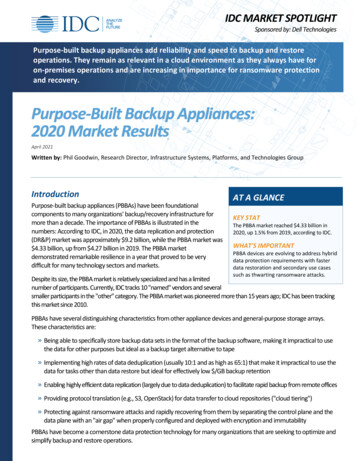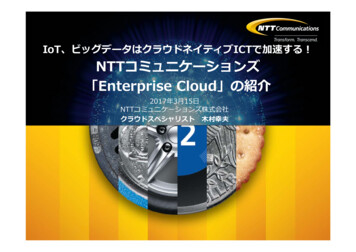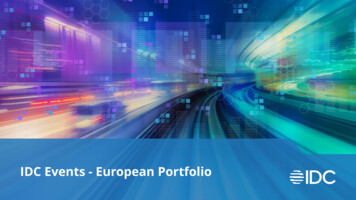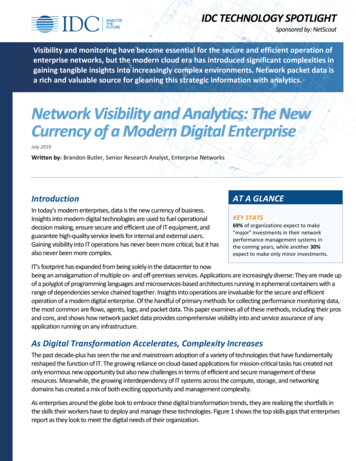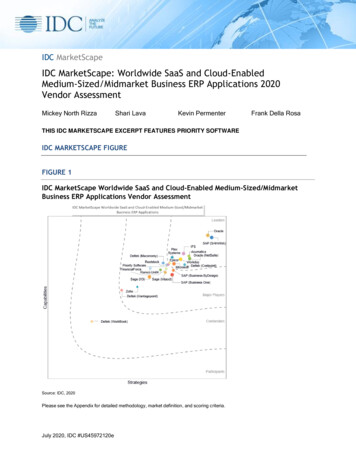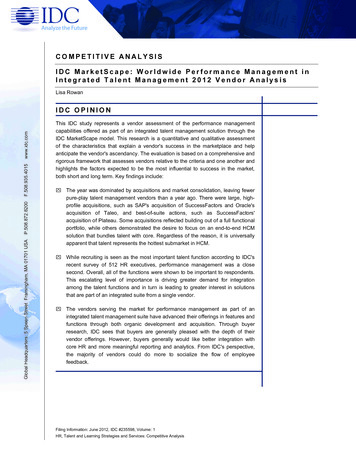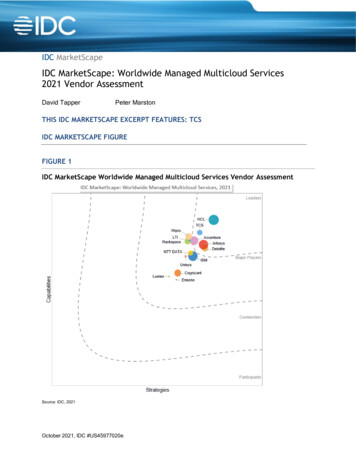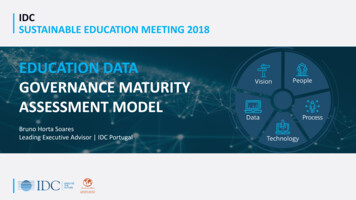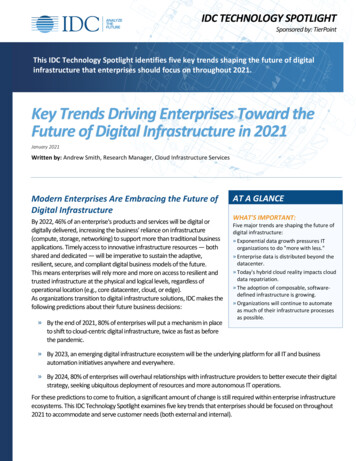
Transcription
IDC TECHNOLOGY SPOTLIGHTSponsored by: TierPointThis IDC Technology Spotlight identifies five key trends shaping the future of digitalinfrastructure that enterprises should focus on throughout 2021.Key Trends Driving Enterprises Toward theFuture of Digital Infrastructure in 2021January 2021Written by: Andrew Smith, Research Manager, Cloud Infrastructure ServicesModern Enterprises Are Embracing the Future ofDigital InfrastructureBy 2022, 46% of an enterprise's products and services will be digital ordigitally delivered, increasing the business' reliance on infrastructure(compute, storage, networking) to support more than traditional businessapplications. Timely access to innovative infrastructure resources — bothshared and dedicated — will be imperative to sustain the adaptive,resilient, secure, and compliant digital business models of the future.This means enterprises will rely more and more on access to resilient andtrusted infrastructure at the physical and logical levels, regardless ofoperational location (e.g., core datacenter, cloud, or edge).As organizations transition to digital infrastructure solutions, IDC makes thefollowing predictions about their future business decisions:» By the end of 2021, 80% of enterprises will put a mechanism in placeAT A GLANCEWHAT'S IMPORTANT:Five major trends are shaping the future ofdigital infrastructure:» Exponential data growth pressures ITorganizations to do "more with less."» Enterprise data is distributed beyond thedatacenter.» Today's hybrid cloud reality impacts clouddata repatriation.» The adoption of composable, softwaredefined infrastructure is growing.» Organizations will continue to automateas much of their infrastructure processesas possible.to shift to cloud-centric digital infrastructure, twice as fast as beforethe pandemic.» By 2023, an emerging digital infrastructure ecosystem will be the underlying platform for all IT and businessautomation initiatives anywhere and everywhere.» By 2024, 80% of enterprises will overhaul relationships with infrastructure providers to better execute their digitalstrategy, seeking ubiquitous deployment of resources and more autonomous IT operations.For these predictions to come to fruition, a significant amount of change is still required within enterprise infrastructureecosystems. This IDC Technology Spotlight examines five key trends that enterprises should be focused on throughout2021 to accommodate and serve customer needs (both external and internal).
IDC TECHNOLOGY SPOTLIGHTKey Trends Driving Enterprises Toward the Future of Digital Infrastructure in 2021Trend 1: Exponential Data Growth Pressures IT Organizations to Do"More with Less"Enterprises have indicated to IDC that they expect their stored data to grow an average of 30% annually. Using thisgrowth rate as a general guide, we can assume that an organization managing 10PB of data today will store upwards of13PB of data the following year. The challenge with this data growth trajectory is that spending on IT infrastructure isexpected to grow only in the single digits and may even remain flat for many enterprises. This juxtaposition — datagrowth significantly outpacing IT infrastructure spend — puts many organizations in a precarious position. How canenterprises effectively store and protect growing volumes of data without adequate resources? Increasingly, they muststrike a balance between the promise of generating value from data and the reality of running their business applicationscost effectively and securely. In the scramble to keep up with data growth and monetization of enterprise data,organizations cannot lose sight of the fact that their data must be accessible and secure.What It Means for the Future of Digital Infrastructure» IDC expects enterprises to evaluate infrastructure solutions based on their ability to do "more for less," creatingadditional value through investments that are "bite size" and achievable.For example, many enterprises are already ramping up their adoption of cloud-based cold storage solutions andservices to tier data to locations that allow retention at the lowest cost possible. Cold storage services can ensurelong-term access to the data — albeit at slower rates — in the event it is deemed valuable or necessary fordigital initiatives.» Similarly, we expect that the digital infrastructure initiatives of many enterprises will include a reevaluation of theirstorage workloads on a continuum of "hot" to "cold" in terms of their data access and application latencyrequirements. Organizations should match workload performance with the right performance tier of storage andconsider solutions that can automate the placement of infrequently accessed data to the most cost-effectivestorage tier.» Enterprises will look for infrastructure platforms that enable agile and consistent scaling of capacity (primarilycompute and storage), utilizing on-demand, workload-specific components. Such platforms will help enterprisesensure they are using their resources effectively and, in the case of a services offering, paying for only theinfrastructure resources they utilize.#US47355821Page 2
IDC TECHNOLOGY SPOTLIGHTKey Trends Driving Enterprises Toward the Future of Digital Infrastructure in 2021Trend 2: Enterprise Data Is Distributed Beyond the DatacenterDigital services increasingly reside in diverse clouds and new network/business edge locations, not just in core enterprisedatacenters. IDC believes that overall, the "edge" represents a new frontier in the convergence of infrastructure domainssuch as compute, storage, and networking (more specifically, moving compute to where the data is created), which will giveorganizations the opportunity to dramatically reduce time to value. The edge is not a singular entity, nor is it the name of asingular market; rather, it is a way of recasting infrastructure boundaries beyond the datacenter depending on the use case,industry, or business function. According to IDC's Worldwide Edge Infrastructure Software Forecast, 2020–2024, whichincludes edge compute, storage, and related automation/configuration software, the market for these solutions is forecastto grow at a 2019–2024 compound annual growth rate of 11.5%, reaching 5 billion in 2024.Moreover, the ability to consume/manage resources in the optimal location based on latency, availability, andcompliance characteristics is critical. Challenges such as data sovereignty, IT service at the edge, and reducing connectivitycosts can be simplified and overcome when infrastructure can be placed/consumed anywhere.What It Means for the Future of Digital Infrastructure» The shift toward edge solutions and services will require technologies and operational processes that enablecoordinated placement and use of applications across locations, making it possible for enterprise IT to be moreagile and less location constrained. As a result, enterprises will look to adopt solutions that improve ease ofapplication mobility across different locations, usage models, and cloud platforms.» Most early adopters of edge technologies must be prepared to rely on highly custom deployments. Nowhere is theneed for customization more evident than in the case of compute, where even a slight modification in the computestack can alter the entire makeup of a system or a platform.» As more companies embrace edge as part of their digital infrastructure strategy, they will need to define therequirements of their individual use case. These use cases might include solutions for Internet of Things (IoT)devices on a manufacturing floor or local image or video processing based on artificial intelligence (AI). Unlike thecore and cloud, edge architecture can be heavily use case centric, and we expect organizations undertaking edgeinitiatives to rely on support from third-party partners that specialize in use cases by application (e.g., CRM,databases), industry vertical, or even geographic region to develop a strategy and deploy effective solutions.#US47355821Page 3
IDC TECHNOLOGY SPOTLIGHTKey Trends Driving Enterprises Toward the Future of Digital Infrastructure in 2021Trend 3: Today's Hybrid Cloud Reality Impacts Cloud Data RepatriationWorkloads and data migrated to public cloud infrastructure do not always reside there permanently. Many workloadscan fluctuate between deployment locations until they reach a state of equilibrium. A recent IDC survey shows thatabout 50% of enterprise applications are expected to stay in place over the next year. Additional research conducted byIDC as part of our annual IaaSView Survey indicates that hybrid cloud is the de facto infrastructure standard for manyorganizations. Indeed, 55% of respondents indicated they currently operate in a hybrid cloud environment and use theframework for deploying applications in their optimal location/environment. This adoption of hybrid cloud environments(as opposed to purely on premises or purely public cloud) is indicative of the need for flexibility within enterpriseinfrastructure environments as applications and resources are shifted to the most optimal location depending onperformance, cost, or security requirements.What It Means for the Future of Digital Infrastructure» Enterprise proclivity toward hybrid cloud environments should be seen as evidence that many organizations aretaking a multiphase, workload-centric approach to application placement as opposed to an "all in" strategy thatfavors a single deployment environment regardless of the workload type.» Workload and cloud data repatriation happens; however, it should be seen as an exception rather than the norm.We believe it is more likely that applications will continue to take advantage of mobility (regardless of destination),and enabling that mobility is a critical element of success, rather than trying to determine the ultimate"destination."» When designing or modernizing your infrastructure environment, assume applications will never remain static.Digital transformation and modernization, combined with unforeseen events such as COVID-19 during 2020, willdrive application churn within enterprises as IT budgets change and workforces adjust to a "new normal," which inmany cases means a higher prevalence of remote work and remote access to work systems/tools.Trend 4: The Adoption of Composable, Software-Defined Infrastructure IsGrowingComposable, software-defined infrastructure is a set of not just technologies but also operating principles that align withand enable the future of digital infrastructure. Enterprises are looking to technologies such as function offloadcoprocessors (FOCPs, also referred to as SmartNICs) to create disaggregated, tamperproof infrastructure in which certainoperator-defined capabilities (such as data persistence, security, and networking) are off-limits to the infrastructureadministrator. These types of distributed computing platforms are just starting to gain traction in enterprises. While truehardware disaggregation is still in the future, FOCP-based platforms are already being used to spearhead a newgeneration of software-defined infrastructure composability that can better mitigate the risks associated with putting toomuch control onto a single processor.#US47355821Page 4
IDC TECHNOLOGY SPOTLIGHTKey Trends Driving Enterprises Toward the Future of Digital Infrastructure in 2021What It Means for the Future of Digital Infrastructure» IDC expects services providers and enterprises building their own software-defined infrastructure to utilizeFOCP-based platforms to make it secure, tamperproof, and highly scalable. They will be able to offload not justembedded (kernel-level) functions but also, eventually, management functions onto these FOCPs.» The biggest opportunity for IT buyers lies in discarding comforting notions about "tried and trusted" approaches toinfrastructure, instead leveraging the organization's call for cloud and digital infrastructure initiatives as a way todrive adoption of innovative solutions.Trend 5: Organizations Will Continue to Automate as Much of TheirInfrastructure Processes as PossibleWith the increasing scale of infrastructure accessibility, scalability, and performance, hard-pressed IT organizationswill require automation to help them manage infrastructure assets spread across off-premises environments and onpremises environments. This not only enhances IT productivity but also can help enable self-service portalsfor other constituencies where appropriate (e.g., in provisioning new storage resources on demand whendevelopers need them), making IT more agile and responsive to modern digital infrastructure requirements. Proactiveartificial intelligence/machine learning–powered analytics and policy-driven automation of infrastructure resources andsecurity/compliance protocols are just a few examples of solutions that can deliver significant time savings and costsavings for IT organizations as they seek to streamline infrastructure operations and deliver consistency across all physicaland logical assets. Moving infrastructure operations teams away from reactive monitoring, support and service requests,and ad hoc resource provisioning allows these teams to refocus their efforts on driving AI for IT operations (AIOps)initiatives, delivering greater levels of workload portability, implementing consumption-based usage, and supportingdynamic applications while keeping a handle on cost, performance, security, and compliance.What It Means for the Future of Digital Infrastructure» IT infrastructure buyers will continue to evaluate infrastructure automation solutions based on their ability todeliver time/FTE reductions associated with what would be considered "traditional" infrastructure tasks such asstorage/compute provisioning, load balancing, or performance monitoring. This evaluation will provideorganizations with a starting point to look at measurable improvements as they reduce the hours/FTEs associatedwith legacy tasks and redirect personnel to innovative tasks in support of digital infrastructure initiatives.» The future of digital infrastructure is highly dependent on the ability of complex, connected cloud infrastructure toself-regulate and dynamically optimize itself in response to real-time changes in resource demand, applicationperformance, and end-user experience. IDC expects AIOps will continue to evolve as an important technologicalunderpinning of this vision and a path forward for many organizations to realistically achieve this goal.#US47355821Page 5
IDC TECHNOLOGY SPOTLIGHTKey Trends Driving Enterprises Toward the Future of Digital Infrastructure in 2021Considering TierPointTierPoint offers a portfolio of solutions and services built on a software-defined, hybrid infrastructure. Its flexible,microservices approach to infrastructure aligns well with many of the challenges and trends facing customers in 2021(e.g., data management, infrastructure convergence, and data resilience). As an infrastructure services provider, thecompany positions itself at the critical intersection between cloud (and its many instantiations) and on-premisesenvironments. This makes TierPoint a key partner in enabling the future of digital infrastructure as many enterprises willembark on programs to migrate and modernize infrastructure and workloads in order to enable a more digital business.TierPoint provides a range of solutions and services for multicloud environments based on technology from VMware.TierPoint is a VMware Cloud Verified partner, which means its services are validated and optimized to work alongside ahost of VMware Cloud and VMware Cloud Foundation solutions. Close integration with VMware allows TierPoint to helpcustomers deploy infrastructure resources and applications across hybrid or private cloud, as well as convergedenvironments, regardless of workload requirements. For example, some organizations will define their hybridenvironment according to their service-level agreement (SLA) requirements, building solutions on commodity hardware.Others will seek to leverage new software tools to help scale, manage, and protect their infrastructure while stillleveraging some of their capital-intensive hardware assets. TierPoint can help address either of these scenarios byleveraging a range of automated provisioning tools and life-cycle management solutions that can be deployed bothon premises and in the cloud.Relevant in the context of this paper is the fact that TierPoint also provides consumption-based subscription pricingmodels that align with cloud billing models. Many organizations rely on these consumption-based subscription models tomake cloud migration a cost-effective option. If a customer chooses a multitenant solution from TierPoint, it can price thedeployment per resource pool (which is determined by the storage, compute, and memory sizes utilized). If the customerrequires a private cloud solution, it can separate the capital expenditures of the hardware from the cost of the virtualresources it will be using. Customers also can "burst" their compute and storage capacity and pay an on-demand, hourlyrate as needed to accommodate emergency scale-up or scale-out situations.ChallengesMany of the trends outlined in this analysis will drive opportunity for organizations to partner with a provider such asTierPoint to scale their infrastructure for a specific workload, application, or use case in a cost-effective and timelymanner. Working with partners to drive infrastructure modernization will accelerate delivery and deployment timelinesand help IT decision makers map their organization's digital infrastructure initiatives to the right set of solutions andmanaged services.However, the models of partnership and service delivery required by digital infrastructure solutions can be vastlydifferent from the traditional relationships with VARs or other types of resellers to which many organizations areaccustomed. Several of the trends and solutions that have been outlined in this paper require long-term commitmentand tailored engagement with extremely high levels of service delivery. This changing dynamic will continue to challengeservices providers such as TierPoint to elevate both their technology services portfolios and their customer engagementmodels in order to help customers implement holistic infrastructure solutions that go beyond a single cloud, application,or workload stack.#US47355821Page 6
IDC TECHNOLOGY SPOTLIGHTKey Trends Driving Enterprises Toward the Future of Digital Infrastructure in 2021ConclusionModern enterprises depend on the delivery of digital goods and services, which in many cases can be enabled only byresponsive, scalable, and resilient infrastructure. This digital infrastructure foundationmust also be able to take advantage of third party–provided and –operated solutionsThe future of digitaldelivered as a service. The future of digital infrastructure does not reside just in centralinfrastructure doesdatacenters. Rather, it includes assets in edge locations such as network points ofnot reside just inpresence, buildings, campuses, and metro colocation facilities that deliver enhancedcustomer experiences, embed intelligence into business operations, and supportcentral datacenters.ongoing industry innovations. The five trends outlined in this paper should serve toillustrate some of the opportunities and challenges faced by organizations as they seekto modernize and innovate. With these trends in mind, IDC offers the following advice to technology solutions andservices buyers thinking about their digital infrastructure and business initiatives:» Evaluate infrastructure solutions and services providers based on their ability to provide access to newtechnologies, capabilities, and services based on business and application requirements specific to the enterprise.» Establish a preference for infrastructure solutions that include automated/proactive upgrades of software andhardware assets to minimize the accumulation of technical debt and any associated security or compliance risk.» Evaluate infrastructure modernization efforts based on their ability to progressively reduce and/or eliminate therisk of stranded capacity and waste associated with legacy applications.» Assume that modern applications and workloads will require infrastructure solutions that can be provisioned andmanaged both on premises and in the cloud and that application portability will remain constant.About the AnalystAndrew Smith, Research Manager, Cloud Infrastructure ServicesAndrew Smith is a Research Manager within IDC's Enterprise Infrastructure Practice. Andrew's researchfocuses on public cloud infrastructure-as-a-service platforms and solutions, with specific focus on storageservices. Andrew contributes to market sizing and forecast efforts across IDC's Public Cloud IaaS segments,as well as adjacent markets like multicloud data management, data protection as a service, and public cloudcold storage.#US47355821Page 7
IDC TECHNOLOGY SPOTLIGHTKey Trends Driving Enterprises Toward the Future of Digital Infrastructure in 2021MESSAGE FROM THE SPONSORTierPoint (tierpoint.com) is a leading provider of secure, connected data center and cloud solutions at the edge of theinternet. The company has one of the largest customer bases in the industry, with thousands of clients ranging fromthe public to private sectors, from small businesses to Fortune 500 enterprises. TierPoint also has one of the largestand most geographically diversified footprints in the nation, with over 40 world-class, connected data centers in 20U.S. markets. TierPoint offers a comprehensive solution portfolio of private, multitenant, managed hyperscale, andhybrid cloud, plus colocation, disaster recovery, security, and other managed IT services.The content in this paper was adapted from existing IDC research published on www.idc.com.IDC Research, Inc.5 Speen StreetFramingham, MA 01701, USAT 508.872.8200This publication was produced by IDC Custom Solutions. The opinion, analysis, and research results presented herein are drawn frommore detailed research and analysis independently conducted and published by IDC, unless specific vendor sponsorship is noted. IDCCustom Solutions makes IDC content available in a wide range of formats for distribution by various companies. A license to distributeIDC content does not imply endorsement of or opinion about the licensee.Twitter @IDCExternal Publication of IDC Information and Data — Any IDC information that is to be used in advertising, press releases, or promotionalmaterials requires prior written approval from the appropriate IDC Vice President or Country Manager. A draft of the proposeddocument should accompany any such request. IDC reserves the right to deny approval of external usage for any reason.idc-insights-community.comCopyright 2021 IDC. Reproduction without written permission is completely forbidden.F 508.935.4015www.idc.com#US47355821Page 8
As organizations transition to digital infrastructure solutions, IDC makes the following predictions about their future business decisions: » By the end of 2021, 80% of enterprises will put a mechanism in place to shift to cloud-centric digital infrastructure, twice as fast as before the pandemic.
